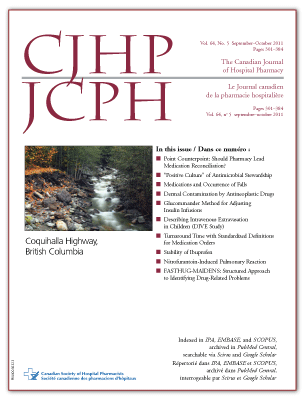Describing Intravenous Extravasation in Children (DIVE Study)
DOI:
https://doi.org/10.4212/cjhp.v64i5.1069Keywords:
extravasation, IV medications, pediatrics, hyaluronidase, médicaments intraveineux, pédiatrieAbstract
ABSTRACT
Background: Extravasation, the inadvertent leakage of intravenous (IV) medication from the vein into the surrounding tissue, is a iatrogenic cause of patient injury. Extravasation has been reported to occur in 0.1% to 6.5% of hospital inpatients. The incidence may be higher among children because they have multiple risk factors, including small and fragile veins, decreased peripheral circulation, capillary leakage, and flexible subcutaneous tissue.
Objectives: To describe the incidence of extravasation at a pediatric tertiary care hospital, to identify the agents causing extravasation, and to describe the use of antidotes to manage identified cases. A secondary objective was to describe adverse drug effects associated with the antidotes administered.
Methods: The medical records of pediatric patients with documented extravasation of an IV medication between January 1, 2006, and August 31, 2008, were analyzed retrospectively. The appropriateness of antidote use was determined in terms of adherence to the institution’s protocol for treatment of extravasation.
Results: A total of 42 patients had documented extravasation, for an overall incidence of 0.04% per patient-day. Of the 40 cases in which location was documented, 12 (30%) occurred on the general pediatric wards, 10 (25%) on the surgical ward, 9 (22%) in the neonatal intensive care unit, 5 (12%) in the pediatric intensive care unit, 3 (8%) in day care, and 1 (2%) in the emergency department. The most common medications involved were fluids for IV administration (18 [43%]), potassium chloride (11 [26%]), antibiotics (8 [19%]), total parenteral nutrition (8 [19%]), calcium chloride (2 [5%]), and epinephrine (2 [5%]). Multiple drugs were involved in some cases of extravasation. The decision to administer an antidote and the choice of antidote (if required) were appropriate in 50% of the cases. No adverse drug effects were reported with use of antidotes.
Conclusions: The incidence of extravasation was low. The medications most commonly involved were similar to those reported in the literature. Antidotes were well tolerated but were appropriately used in only half of the events. Prospective trials are needed to determine the clinical severity of injury and to assess the effectiveness and safety of antidotes.
RÉSUMÉ
Contexte : L’extravasation, la fuite accidentelle d’un liquide administré par voie intraveineuse dans le tissu environnant, est une cause iatrogène de lésions causées aux patients. On a signalé des cas d’extravasation chez 0,1 à 6,5 % des patients hospitalisés, et ce pourcentage pourrait être plus élevé chez les enfants, à cause des multiples facteurs de risque dans cette population, dont des petits vaisseaux fragiles, une circulation périphérique réduite, une hyperperméabilité capillaire et la flexibilité du tissu sous-cutané.
Objectifs : Décrire l’incidence d’extravasation dans un hôpital de soins tertiaires pour enfants, déterminer les agents qui en sont responsables et décrire l’emploi des antidotes pour prendre en charge ces cas. Un objectif secondaire était de décrire les effets indésirables associés aux antidotes administrés.
Méthodes : Une analyse rétrospective des dossiers médicaux faisant état d’extravasation d’un médicament administré par voie intraveineuse chez des enfants hospitalisés à l’établissement des auteurs entre le 1er janvier 2006 et le 31 août 2008 a été effectuée. La pertinence de l’emploi des antidotes a été déterminée en termes de conformité au protocole de l’établissement pour la prise en charge spécifique des cas d’extravasation.
Résultats : Des cas d’extravasation étaient consignés chez un total de 42 patients, pour un taux d’incidence global de 0,04 % par journée-patient. Des 40 cas pour lesquels le lieu où s’est produit l’incident a été noté, 12 (30 %) sont survenus dans le service de pédiatrie générale, 10 (25 %) dans le service chirurgical, 9 (22 %) dans l’unité de soins intensifs néonatals, 5 (12 %) dans l’unité de soins intensifs pédiatriques, 3 (8 %) dans le centre de jour et 1 (2 %) dans le service des urgences. Les produits les plus souvent associés aux cas d’extravasation étaient les liquides pour perfusion intraveineuse (18 [43 %]), le chlorure de potassium (11 [26 %]), les antibiotiques (8 [19 %]), l’alimentation parentérale totale (8 [19 %]), le chlorure de calcium (2 [5 %]) et l’épinéphrine (2 [5 %]). Plus d’un médicament était en cause dans certains cas d’extravasation. La décision d’administrer un antidote et, le cas échéant, le choix de l’antidote étaient appropriés dans 50 % des cas. Aucun effet indésirable associé à l’emploi des antidotes n’a été observé.
Conclusions : Les cas d’extravasation étaient rares. Les produits les plus souvent mis en cause étaient similaires à ceux décrits dans la littérature. Les antidotes étaient bien tolérés, mais n’étaient appropriés que dans la moitié des cas. Des études prospectives sont nécessaires afin de déterminer la gravité des préjudices sur le plan clinique et d’évaluer l’efficacité et l’innocuité des antidotes.
Downloads
Published
Issue
Section
License
Copyright © Canadian Society of Healthcare-Systems Pharmacy.
After publication of a manuscript in the CJHP, the authors of the manuscript must obtain written permission from the CSHP (publications@cshp.ca) before reproducing any text, figures, tables, or illustrations from the work in future works of their own. If a submitted manuscript is declined for publication in the CJHP, all said rights shall revert to the authors. Please note that any forms (e.g., preprinted orders and patient intake forms) used by a specific hospital or other health care facility and included as illustrative material with a manuscript are exempt from this copyright transfer. The CJHP will require a letter from the hospital or health care facility granting permission to publish the document(s).










